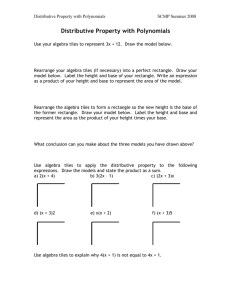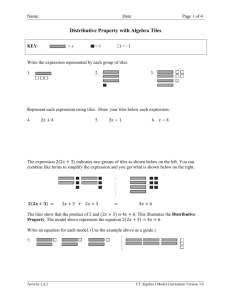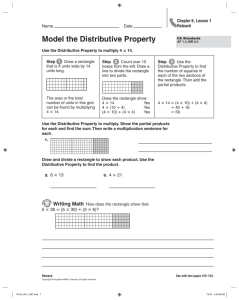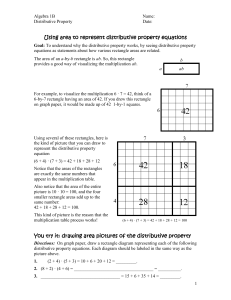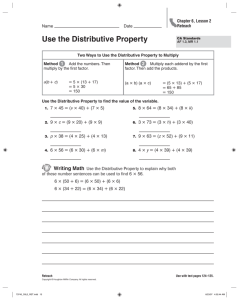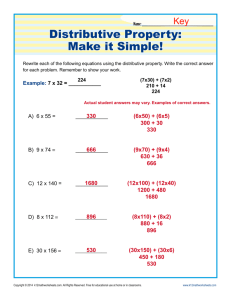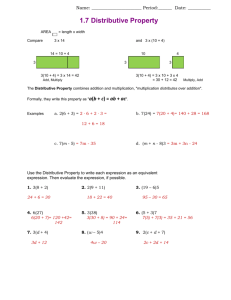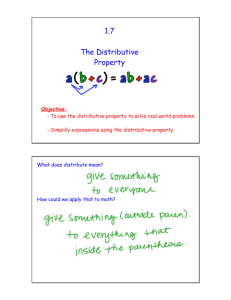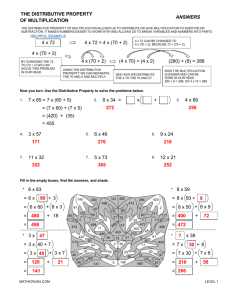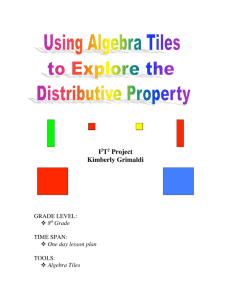Algebra I Distributive Property
advertisement
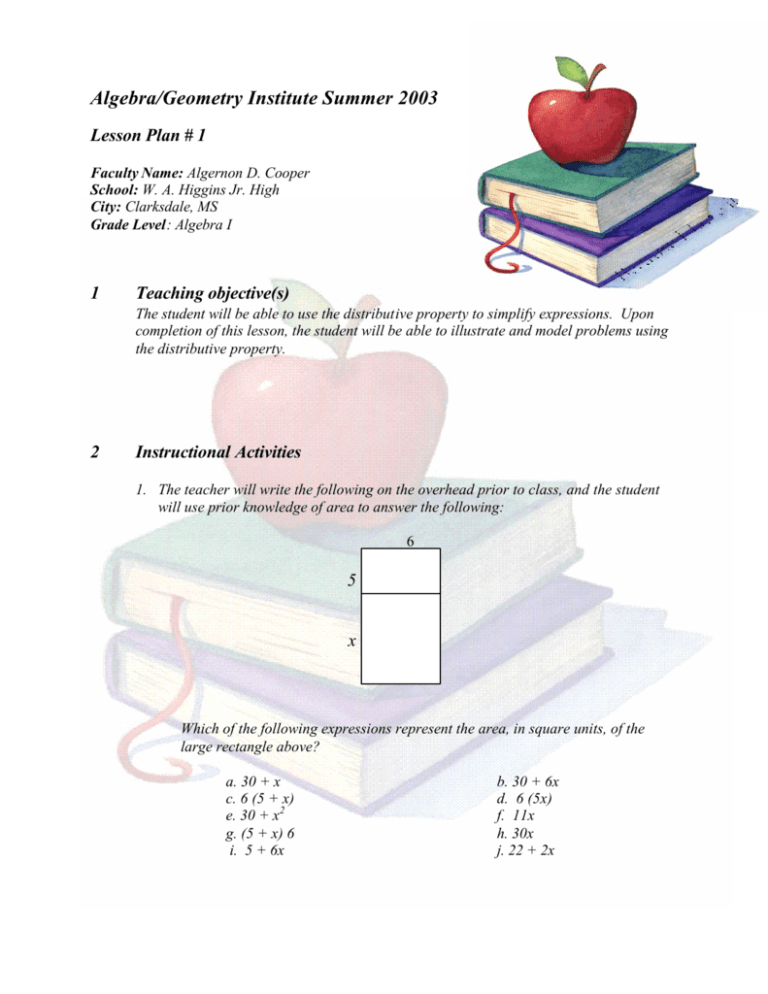
Algebra/Geometry Institute Summer 2003 Lesson Plan # 1 Faculty Name: Algernon D. Cooper School: W. A. Higgins Jr. High City: Clarksdale, MS Grade Level: Algebra I 1 Teaching objective(s) The student will be able to use the distributive property to simplify expressions. Upon completion of this lesson, the student will be able to illustrate and model problems using the distributive property. 2 Instructional Activities 1. The teacher will write the following on the overhead prior to class, and the student will use prior knowledge of area to answer the following: 6 5 x Which of the following expressions represent the area, in square units, of the large rectangle above? a. 30 + x c. 6 (5 + x) e. 30 + x2 g. (5 + x) 6 i. 5 + 6x b. 30 + 6x d. 6 (5x) f. 11x h. 30x j. 22 + 2x 2. The teacher will allow the students time to work the problem. 3. The teacher will then discuss which choices are correct (b, c, and g) and tell the students why the choices are correct. 4. The teacher will then read the following to the students: There are four children in the Cooper family Katriel, AJ, Algernon, and Mike. Katriel and Algernon play basketball, AJ and Mike prefer tennis. Mr. and Mrs. Cooper buy 2 pairs of basketball shoes for $79.95 each and 2 pairs of tennis shoes for $69.97 each. How much do they spend on athletic shoes? 5. The teacher will illustrate that the problem can be solved in two ways: a. Total cost: 2 x (cost of basketball shoes plus the cost of tennis shoes) 2 ($79.95 + $ 69.97 = 2 (149.92) = $299.84 b. Total cost: (2 x cost of basketball shoes) + (2 x cost of tennis shoes) 2($79.95) + 2($69.97) = $159.90 + $139.94 = $299.84 6. The teacher will then explain that these problems were solved using the distributive property. 7. The teacher will write the distributive property on the overhead: The Distributive Property a( b+c)= ab +ac and (b +c)a = ba +ca And a (b-c) = ab-ac and (b-c)a = ba-ca 8. The teacher will explain that the distributive property works both ways; that is, it doesn’t matter whether a is placed on the right or the left of the expression in parentheses. 9. The teacher will write the following problem on the overhead to illustrate the distributive property: Find the area of the basketball court in two different ways: © 42 ft ª© 42ft ª Ÿ 50 10. The teacher will display on the overhead the two methods: a. Method 1: Multiply the width by the length. A = 50 (42+42) = 50 (84) = 4200 ft2 b. Method 2: Add the areas of the smaller rectangles. A = 50 (42) + 50 (42) = 2100 + 2100 = 4200 ft2 11. The teacher will discuss each method with the class, and the answer. 12. The teacher will write the following problem on the board, ask the students to simplify, and wait for responses. 2(5) (8) The teacher would respond by saying that some of the students make the common mistake of distributing the two instead of multiplying straight across. For example: 2(5) + 2(8) = 26 13. The teacher will illustrate the distributive property using the following example: 11 (8+2) 14. The teacher will explain that you first multiply 11 times 8, which is 88, and multiply 11 times 2 which is 22, then add 88 plus 22, and the answer will be 110. 15. The teacher will allow students to get into groups of three. One student will be the private investigator, the person that gives the instruction, one student will be the recorder, the person that writes the problem down, and the last student will be the reporter, the person that explains the problem to the class. 16. The teacher will give each group of students time to simplify the following problems: a. b. c. d. 4(a2 + 3ab) 6 (7 – 3) 3 (5am – 4) 6 (5a + 3b – 2b) 17. The teacher will walk around and monitor each group. 18. Upon completion, the class will discuss orally the results for the problems and the groups will be called upon to discuss how they came up with their results. 19. The students will remain in their groups 20. Each group will be issued a bag of algebra tiles and a product mat. 21. The teacher will explain to the students that they have used rectangles to model multiplication. For example, the problem shows the multiplication as 2(3 +1) as a rectangle that is 2 units wide and 3 + 1 units long. Its area is 2• 3 + 2 • 1 or 8 square units. 22. The teacher will explain to the students that they will be using special tiles called algebra tiles to form rectangles showing multiplication. The teacher will explain that the large tile is a square that is x units long and x units wide. Its area is x 2 . The rectangular tile is 1 unit wide and x units long. Its area is x units. The small tile is a square that is 1 unit long and 1 unit wide. 23. The following example will be written on the overhead: 2 (x + 2). 24. The teacher will explain that the rectangle has a width of 2 units and a length of x + 2 units. The students will use their area tiles to mark off the dimensions on a product mat. 25. Using the marks as a guide, the teacher will make the rectangle with the algebra tiles. 26. The rectangle has 2 x- tiles and 4 1-tiles. The area of the rectangle is x + 1 +1 +x + 1+ 1, or 2x + 4. 27. The students will then model the following to find each product using the area tiles. a.2 (x +1) b. 3 (x +2) c. 2 (2x +1) d. 2 (3x +3) 28. The teacher will walk around and monitor each group. 29. Upon completion, selected groups will model each solution on the overhead, and discuss how they came up with their solutions to the models. 3 Materials and Resources Pencil Paper Overhead projector Textbook ---Algebra I ---Applications and Connections, Merrill (1995) Algebra tiles Product mat 4. Assessment Teacher observation of student participation Student participation on distributive property Skill test Models
